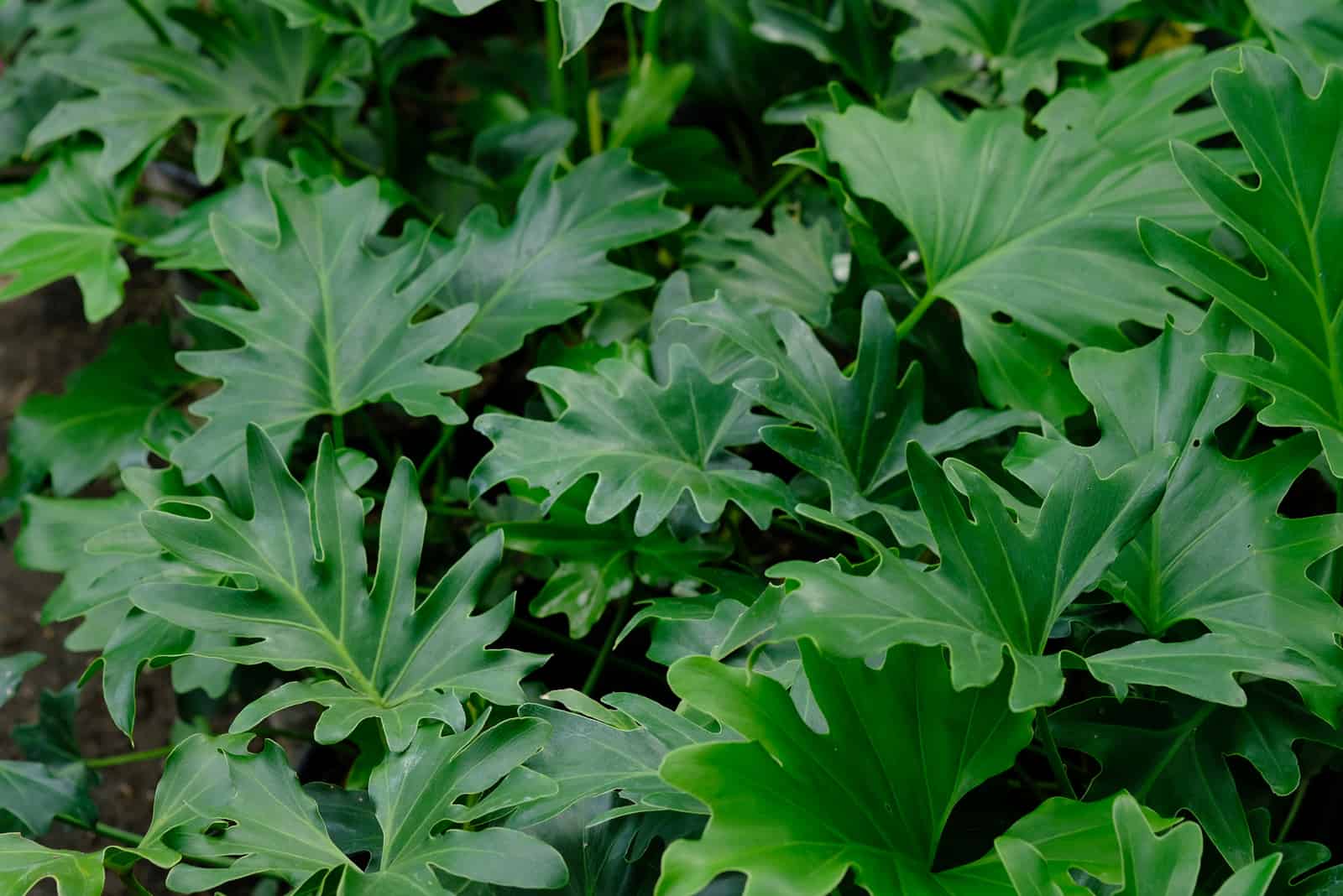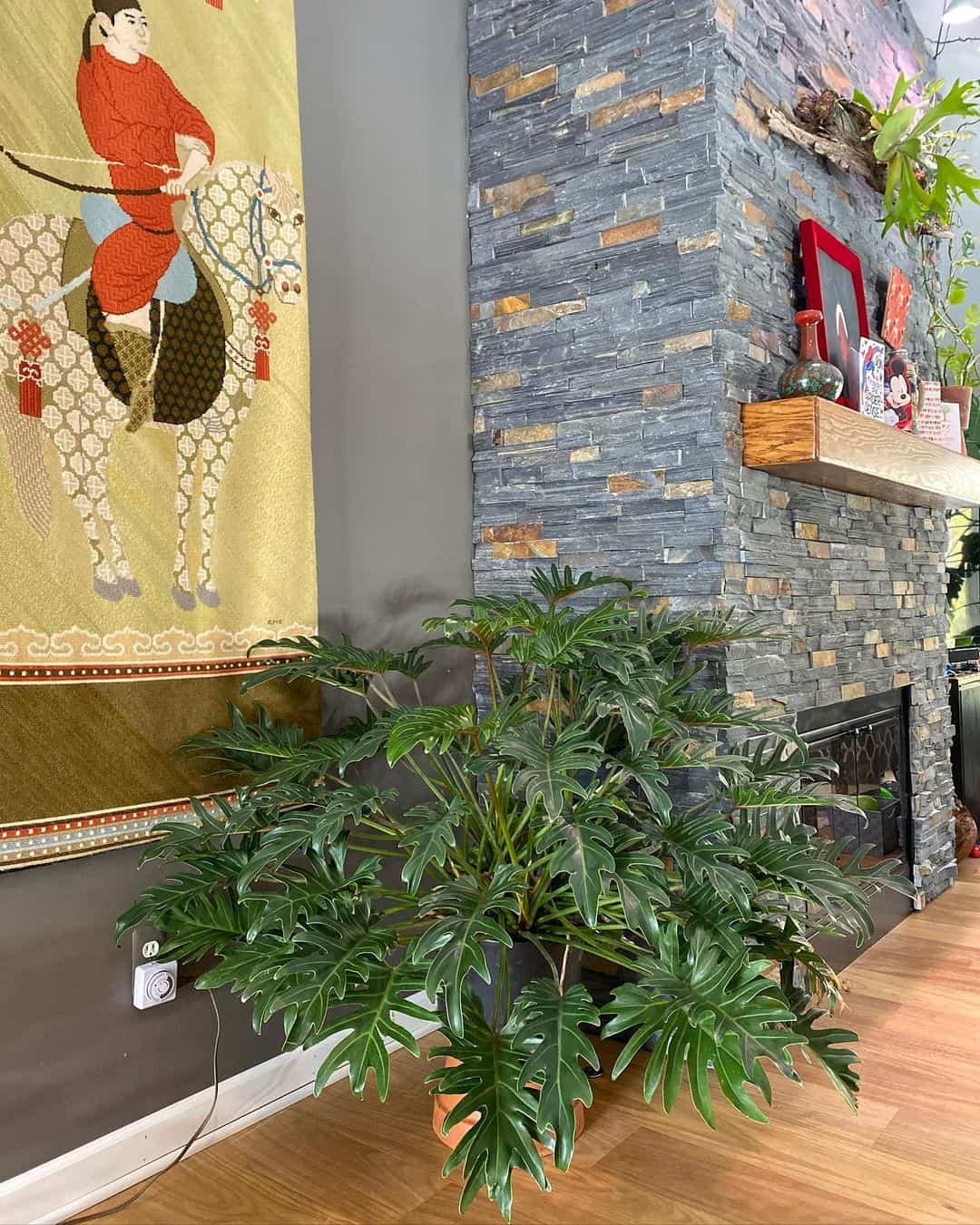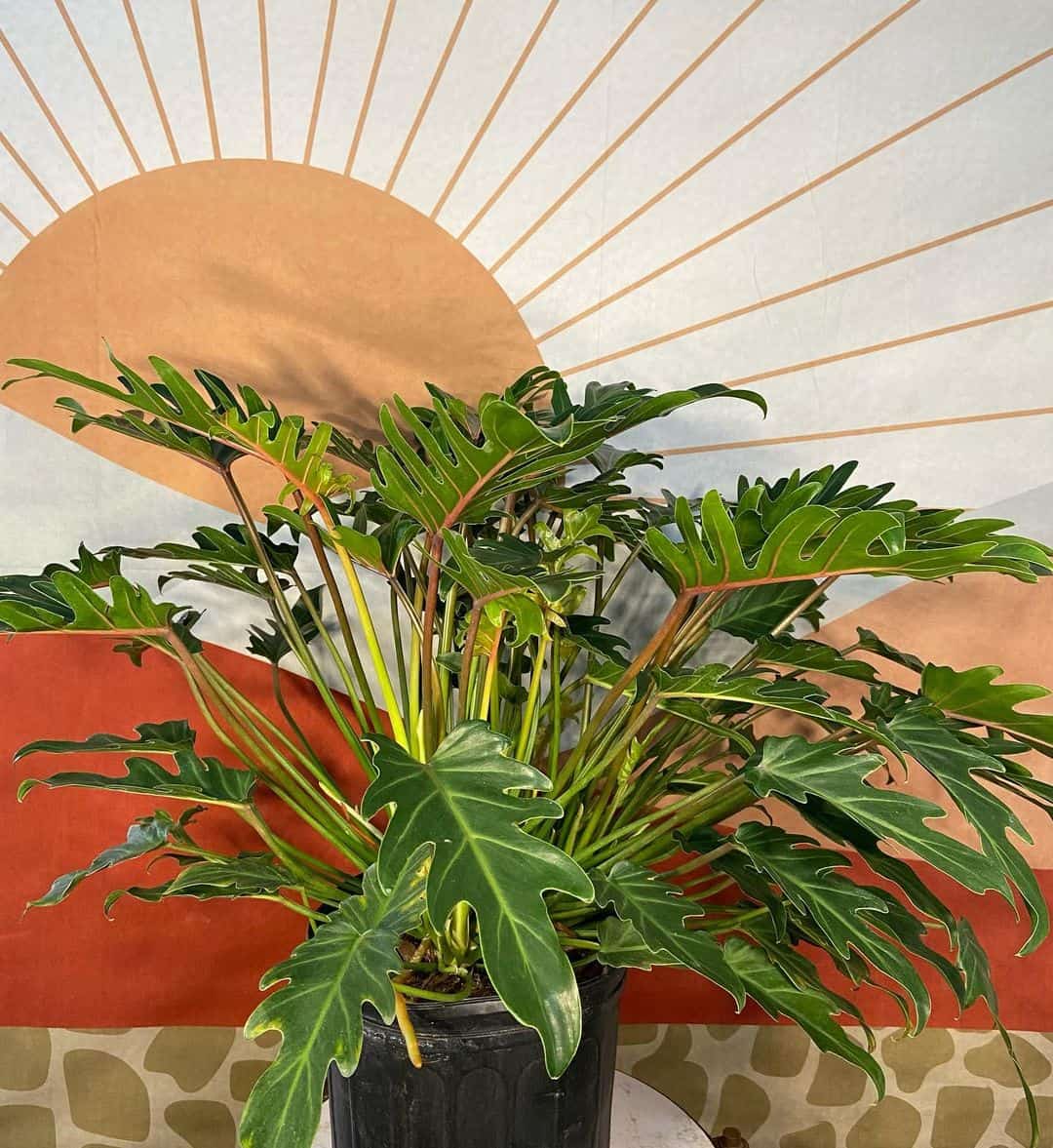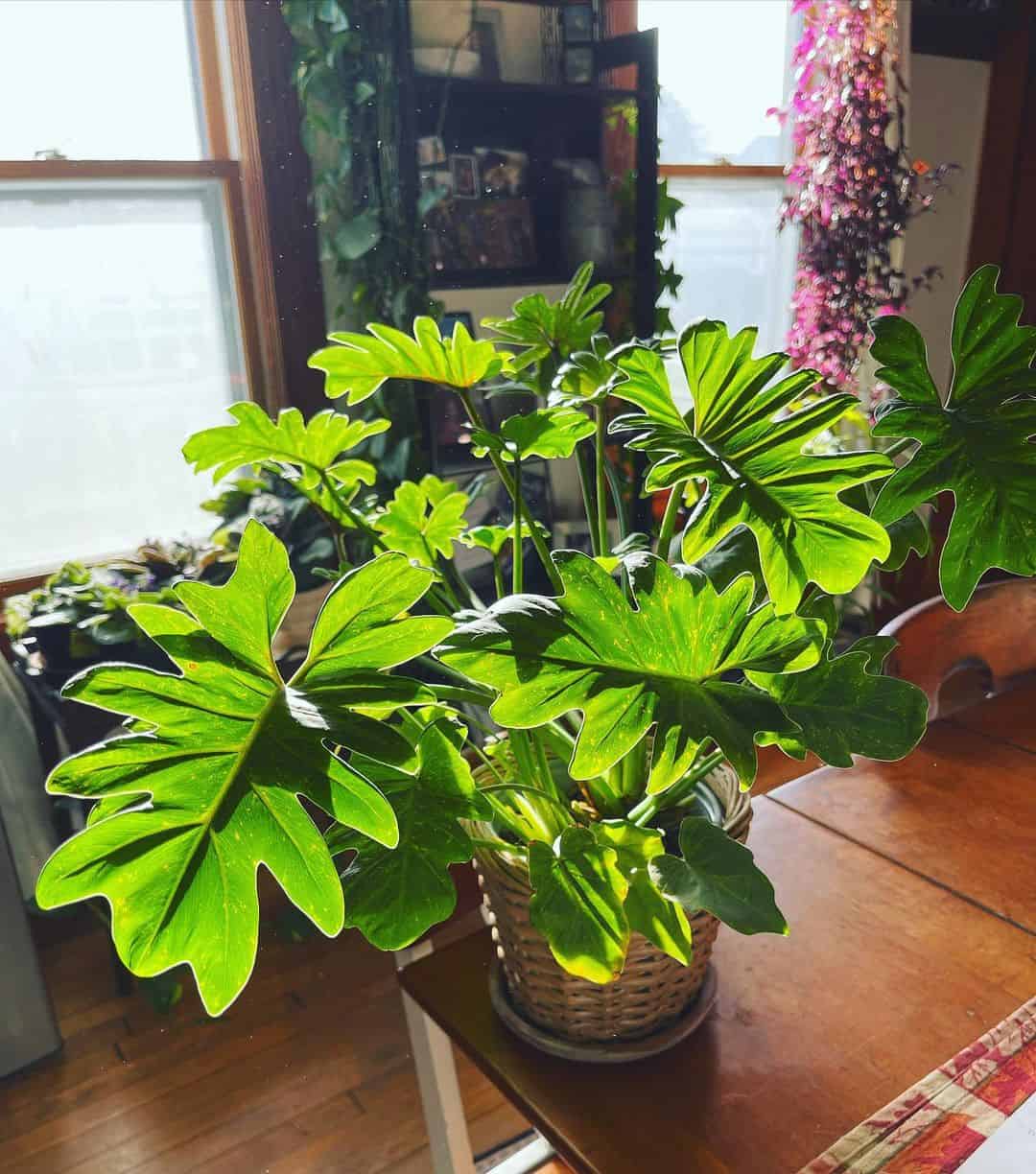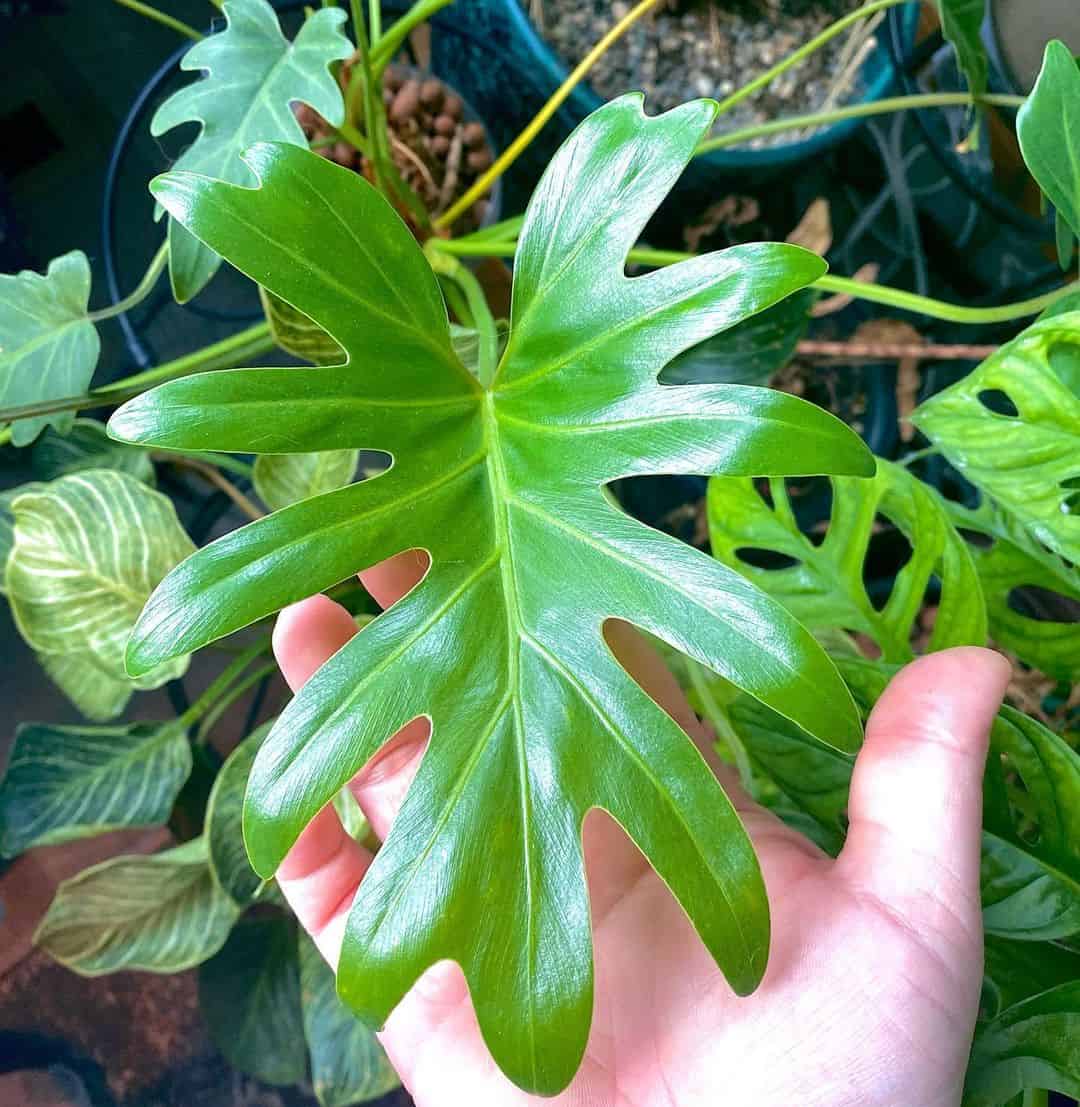If you have always wanted your very own greenhouse, but aren’t quite sure where to start, then Philodendron Deja Vu is the ideal option as it doesn’t require much care, but will still look great in your greenhouse.
Here’s some general information about this awesome plant:
| Scientific name: | Thaumatophyllum bipinnatifidum |
| Native habitat: | Brazil and Mexico |
| Size: | up to 4 feet (1,2 meters) in ideal conditions, but usually 24 inches (60 cm) |
| Growth rate: | slow to moderate |
| Grow zone: | 9-11 |
| Type: | Perennial |
These are just some of the basic features of philodendron deja vu plants, so if you want to learn more about how to take care of them, check out our extensive care guide below.
You’ll also find some interesting facts about Thaumatophyllum bipinnatifidum, as well as some answers to frequently asked questions.
Philodendron Deja Vu Care Guide
Photo from: @plants_in_out
From now on, we will refer to Thaumatophyllum bipinnatifidum by its common name, philodendron deja vu.
This philodendron is perfect for a small greenhouse or indoor collection of aroids and tropical plants because it is very easy to maintain. (You might even make a few mistakes before this beauty gets angry and bites back!).
All you need to do is show it a minimum of Philodendron care, and you will be able to enjoy its greenery for many years to come.
Light
The Low light requirements of the philodendron deja vu make it a perfect indoor plant.
It loves indirect light, so exposing it to bright noon sunlight would be the death of it. Well, not literally, but it would make its leaves shrivel and lose their captivating green color.
Therefore, keeping this philodendron as an outdoor plant is not the best option, unless your outdoor garden contains partial shade. If not, growing it as a houseplant is the best option.
This means that the philodendron has specific requirements for light conditions, but these aren’t something that should put you off buying one.
You can simply keep it near a south or west-facing window and it should be just fine.
Water And Humidity
There are a few things you need to keep in mind when it comes to watering a philodendron deja vu.
Its water requirements are fairly low (it can actually go several weeks without water), considering it’s a subtropical and tropical plant. However, you must water it more often during the hot summer months.
You should only water this philodendron when the topsoil is completely dry. And don’t just rely on your vision; stick your finger about 3 inches (7 cm) into the soil to check the dryness. If it’s dry as a bone, you should water it again.
A good trick is to use a well-draining pot that doesn’t hold water for a long time. If the plant is drowning in water, it will have a hard time breathing. It needs air just like we do, so don’t deprive your plant of oxygen.
Also, overwatering may cause root rot, the leaves to turn yellow, and eventually the death of the plant.
Achieving Perfect Humidity
The Philodendron deja vu is native to high humidity environments, so you should moisturize it more if you live in a drier climate. This may be easily done by using the pebble tray method or, if you want to make your job easier, you can always invest in a regular humidifier.
If you believe in more natural treatments, then you should try the pebble tray method.
As the name of this method suggests, you need a tray filled with water and some pebbles so that the roots of your plant don’t come into contact with the excess water, which would otherwise cause root rot.
Water evaporates and raises the humidity level of the room, creating the perfect environment for a philodendron deja vu plant.
You can take your pebble trays to the next level, and improve the overall decor by using decorative pebbles.
Climate And Temperature
Perfect climate conditions for philodendron deja vu are those that resemble or mimic the tropical and subtropical climates of Brazilian and Mexican forests.
These philodendrons love warm climates and any extreme, either hot or cold, would kill them. Hot temperatures cause the drying out of the plant and its eventual collapse. Freezing temperatures, on the other hand, would make its color change from a beautiful green shade to an unsightly yellow or brown.
However, philodendrons love room temperature, or just slightly warmer than this, so keep your thermostat between 65ºF and 75ºF (18-24ºC), and no lower than 60ºF (15ºC) and you shouldn’t have any problems.
Keep in mind that these recommendations are all useless if philodendrons are subject to sudden changes of temperature or drafts.
This is why proper temperature regulation is such an important part of plant care.
Soil And Fertilizer
Philodendron deja vu is very specific about its prefered soil. It should be slightly acidic (pH level between 6.0 and 6.5).
The soil also has to be well-draining, so investing in a succulent or cactus potting mix that is rich in nutrients and organic material is definitely recommended.
These potting mixes can be found everywhere, but if you have only just gotten back from the greenhouse with your new philodendron, and you don’t feel like taking another trip to the nursery and waiting at the checkout, you can always add perlite or sand to your prefered potting soil if you have them at hand.
When fertilizing your philodendron, bear these things in mind:
• Use fertilizers that are rich in nutrients to supply your plant with perfect growing conditions.
• Invest in a good fertilizer that can be dissolved in water, as this allows the nutrients to instantly reach the roots and stimulate growth.
• Only fertilize your philodendron deja vu during growing seasons. In winter, this plant enters dormancy and stops growing, so be sure not to use fertilizer at this time.
Propagation
It is possible to propagate your philodendron deja vu all by yourself, and the good news is that it’s not too complicated, at least with the stems and leaves.
This philodendron can be propagated through stem and leaf cuttings, as well as seeds. Seed propagation is quite difficult, so we will leave it to the experts.
Beginners, like me, are better off sticking to stem cutting propagation for optimal results.
You simply need to cut off a healthy stem below the node and place it directly in water or a pot with a moist, nutrient rich soil.
The root system should develop after two to three weeks, and your new plant will now be ready to go in a pot with a rich soil mix (if you have already propagated in soil and not water, you don’t have to repot it).
Repotting
A great thing about the philodendron deja vu is that you will not have to waste too much time on repotting.
These philodendrons are slow to moderate growers, so they only need to be repotted every now and then (when you can literally see the root system sticking out of the pot). Once you can see those small tentacles reaching out (and this only happens maybe once every two years), it is time to increase the pot size.
Fill the new (bigger) pot with well-draining soil rich in organic content, remove all the dead roots that you can find, and plant the philodendron.
It is ideal to do this during the growing season so that your plant can grow big and strong.
Pruning
Pruning will make your philodendron healthier and its deep green leaves lusher.
Pruning, however, should only be done in dire circumstances.
If you see dull brown and yellow leaves, be sure to cut them off with sterilized pruning shears. This way, you won’t transfer any bacteria that could do potential damage to the plant.
You can cut off the discolored leaves any time of the year, but if you notice your philodendron has started taking up too much space and is all leggy, you can prune it in the spring or fall seasons to give it some time to heal.
Facts About Philodendron Deja Vu
Photo from: @wildterracotta
Now that you know how to take care of a philodendron deja vu plant, it is time to learn some more interesting facts that will inspire you to propagate one for all your friends and family!
Foliage And Flowers
The Philodendron deja vu is unfortunately a non-flowering plant, which is a real shame as the flowers would almost certainly have been as magnificent as its deep green leaves with jagged edges.
Its evergreen leaves make up for the non-existent flowers throughout the whole year, though, and the shiny foliage of this philodendron makes it a prized houseplant.
Common Diseases And Pests
The most common disease that affects the philodendron deja vu is leaf spot. It is easily recognised: just look at the color of your philadendron’s foliage, and if it starts to change from shiny green to yellow, and eventually brown, it’s a sure sign that your plant has been infected.
This problem is easily treated, though: simply cut off the discolored leaves to heal your plant.
Just be sure to keep the leaves dry!
You should also be on the lookout for erwinia blight.
This disease attacks the stem and the foliage, and you can recognise it by yellow or brown blisters on the stem. The good news is that this issue can be cured with bactericides.
If left unattended, a philodendron can attract pests. However, neem oil, insecticidal soap, or rubbing alcohol should get rid of any insects in no time.
Learn More About Philodendrons
Photo from: @the.plant.porch.minneapolis
Genus Philodendron belongs to the Araceae family and has over 500 unique species. Interestingly, they are all epiphytes, which means they live on other plants.
They come in all different shapes and sizes: some can bloom, others cannot, while some even have berry fruit, which is usually a lovely shade of orange. What connects them all is the shape and color of their leaves – they are usually big, shiny leaves in beautiful shades of green.
Some, like Philodendron erubescence cultivars, are variegated and difficult to differentiate, but if you get to know the characteristics of philodendrons White Knight and White Wizard, for instance, you get one step closer to becoming a philodendron expert.
FAQs
We have already answered many questions about philodendrons, but there’s an important one we have yet to address.
Is the philodendron deja vu poisonous?
Yes, the philodendron deja vu is poisonous to both humans and pets.
It isn’t lethal to humans, but you should be extra careful when it comes to animals because this philodendron contains calcium oxalate in its leaves, which can kill your pets!
If people come into contact with the sap of this philodendron, reactions include skin irritation, swelling, and burning of the airways.
If we put toxicity aside, this plant does make for beautiful home decoration. You just need to keep it out of reach of animals and children.
Philodendron Deja Vu vs Xanadu
Philodendron deja vu and philodendron xanadu are quite similar, especially if you compare the shape of their leaves.
Both have green leaves with jagged edges, but there are some key differences.
Philodendron xanadu usually has thicker leaves than deja vu, and philodendron deja vu has less lobes than xanadu, so if you have a tape measure and don’t mind a bit of counting, you should be able to decipher the type of philodendron you’re dealing with.
To Sum Up
Photo from: @rough.around.the.hedges
You can now call yourself a philodendron deja vu expert after reading this article. We have discussed everything you need to know about philodendron deja vu care, as well as its features and some interesting facts you could have missed while reading the card on the back of your new plant.
We hope you have a wonderful experience with this plant, just like we did. Just be careful and wear protective gloves when handling it, and you’ll be fine.
Until next time!

